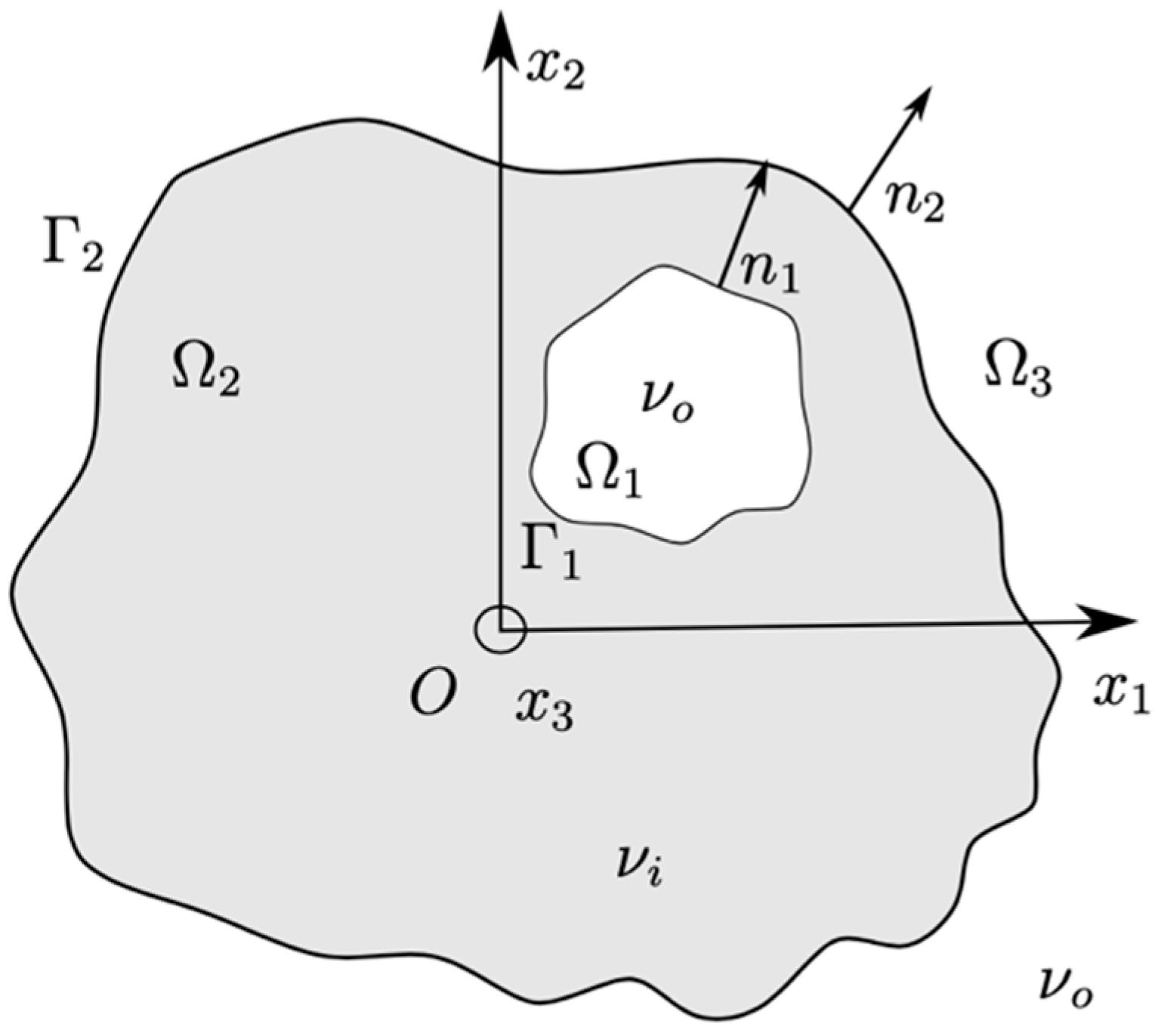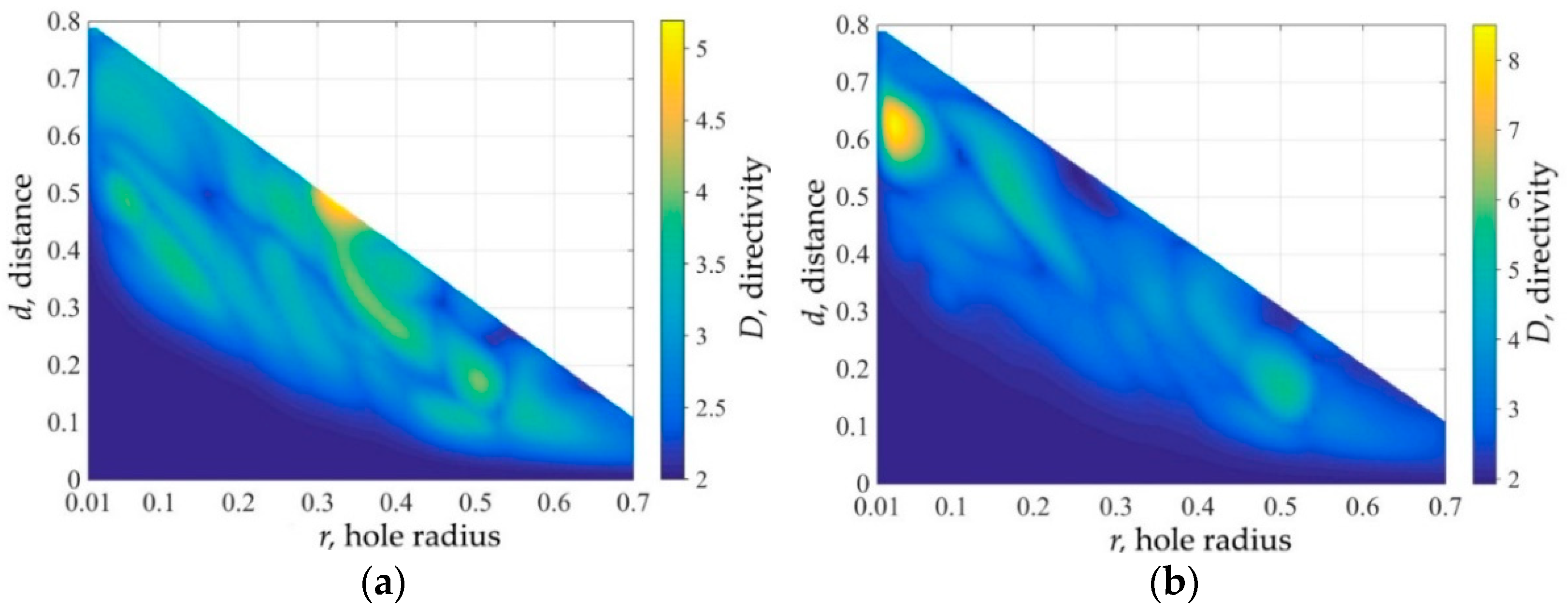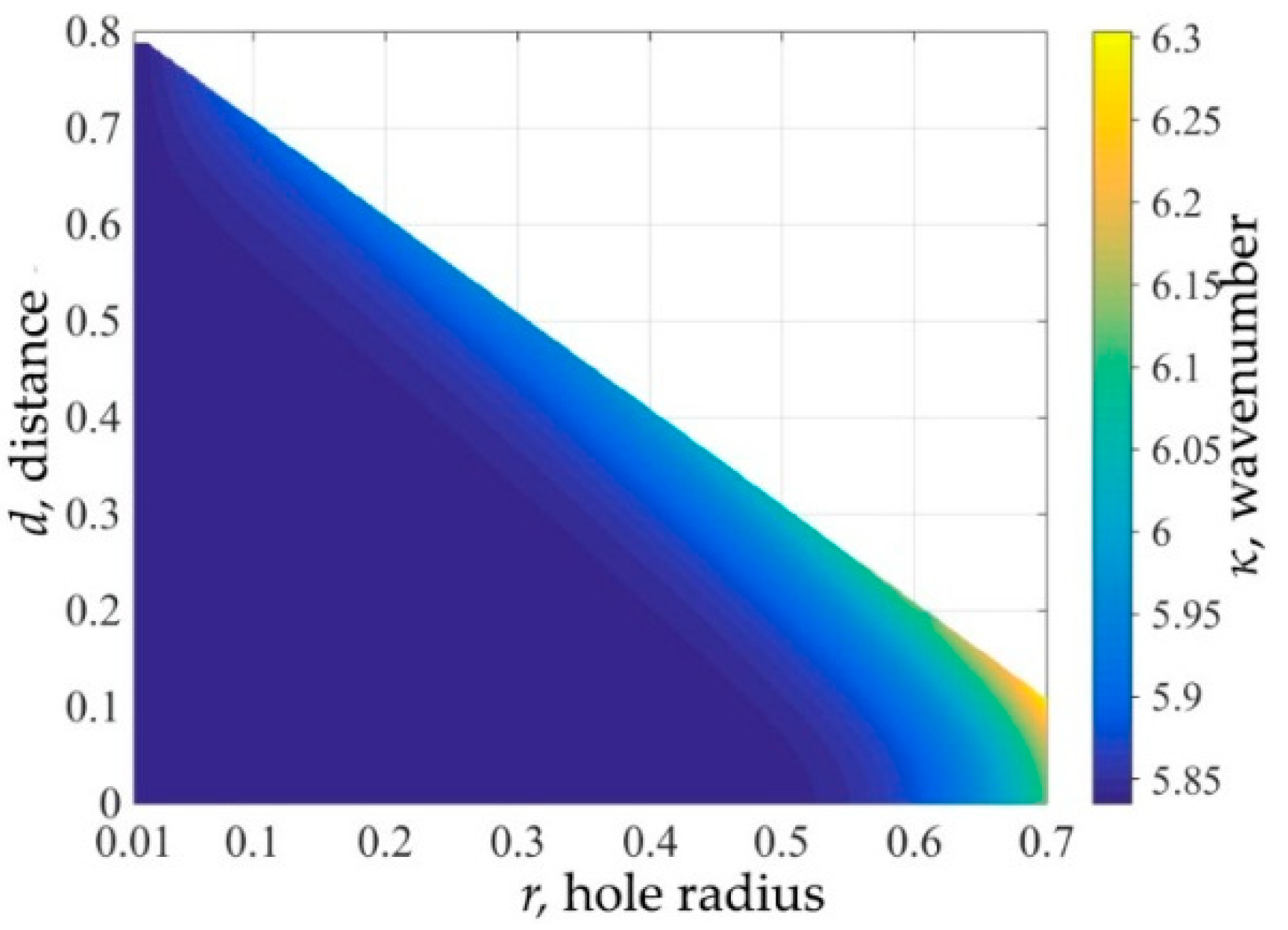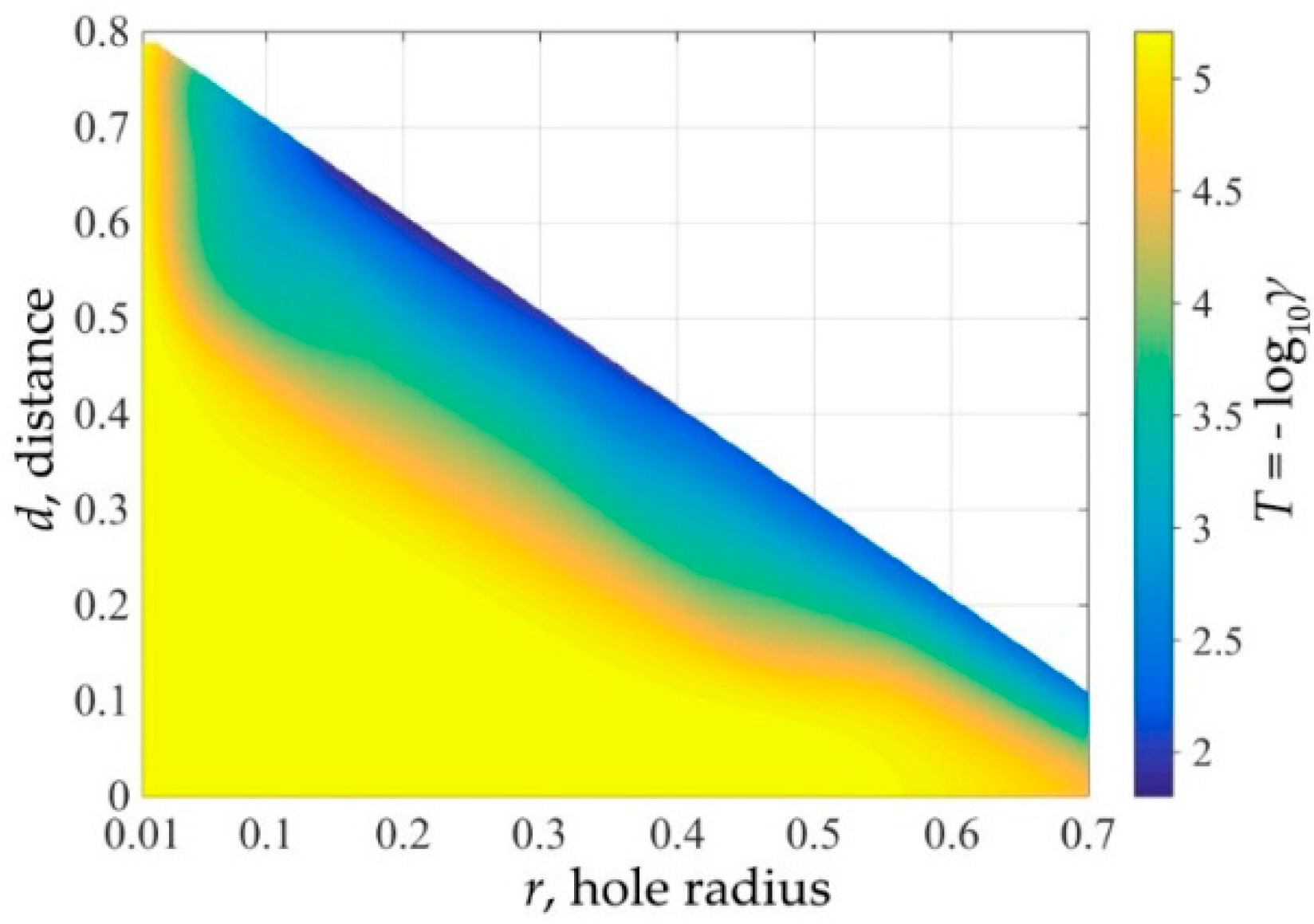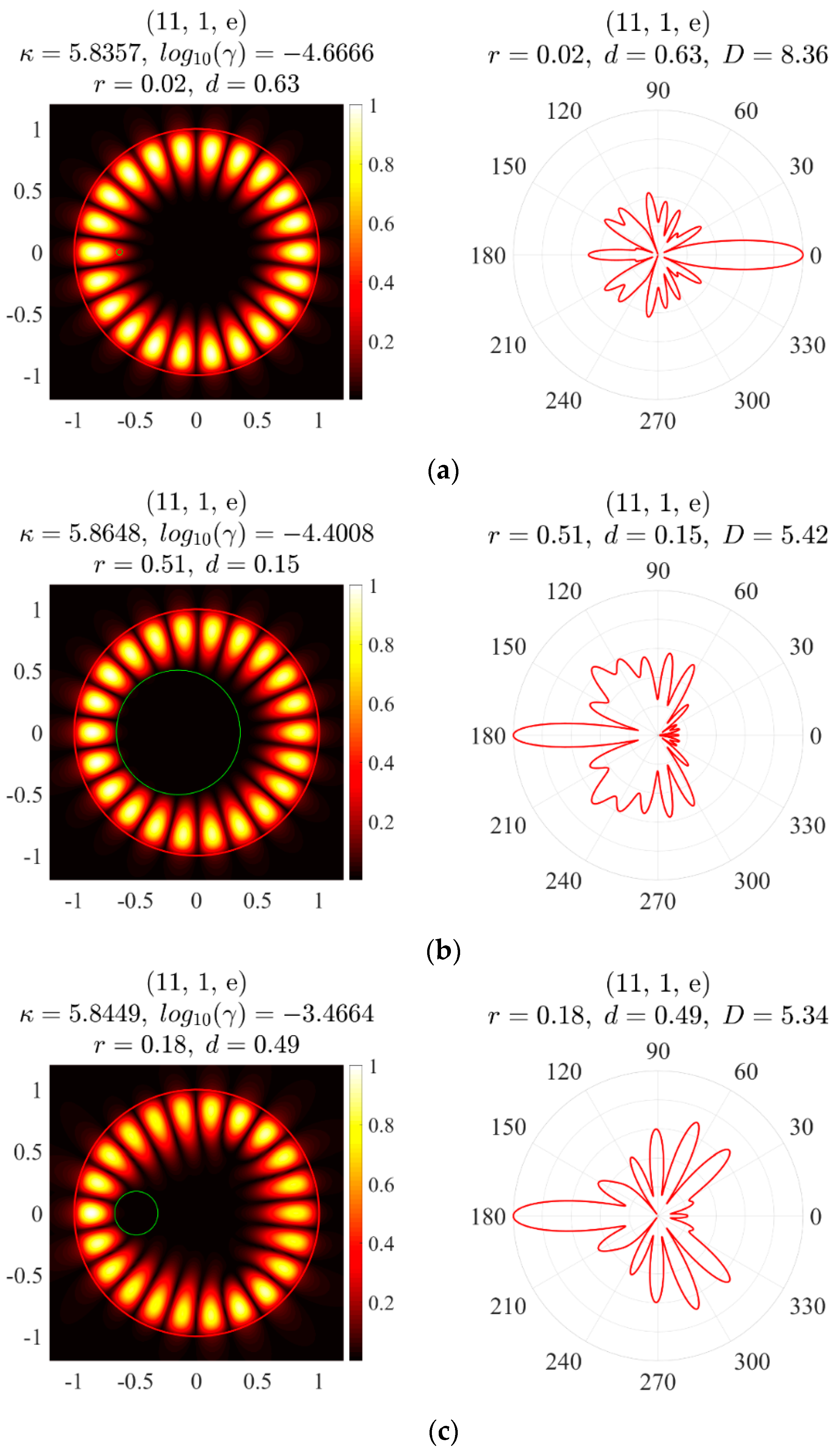1. Introduction
Various two-dimensional (2D) models of microdisk and microring lasers (see, e.g., [
1,
2]) can be investigated with the aid of a specific electromagnetic eigenvalue problem adapted to calculate the threshold values of gain, in addition to the emission frequencies, which is called the lasing eigenvalue problem (LEP) [
3,
4,
5,
6,
7]. For 2D microcavity lasers with uniform gain, LEP was reduced in [
8] to a nonlinear eigenvalue problem for the system of the Muller boundary integral equations (BIEs). This system, obtained by Muller in [
9], is widely used in the analysis of electromagnetic-wave scattering from 2D and 3D homogeneous dielectric objects with smooth boundaries [
10,
11]. This is because Muller BIEs are the Fredholm second-kind equations, which guarantee the convergence of their numerical solutions. By the same reasons, the eigenmodes of fully active [
6,
8] and passive [
12] microcavities can be calculated using Muller BIEs. Many authors, as in [
12], have used a physical model called the complex-frequency eigenvalue problem (CFEP). It is based on the search for complex-valued natural frequencies of open passive resonators. To be able to build a general theory for both LEP and CFEP models, a generalized model was proposed in [
8]. It obtained the following name: generalized complex-frequency eigenvalue problem (GCFEP) [
8]. The reason for reducing GCFEP to the Muller BIEs was to get a system of weakly singular integral equations [
13] on the boundary of the microcavity laser. However, there is no full equivalence between GCFEP and the eigenvalue problem for the system of Muller BIEs [
14]. Namely, it was proven in [
15] that for each eigenfunction of GCFEP there is a corresponding eigenvector of the system of Muller BIEs. Still, the assertion in the opposite direction is not true: there is one more problem that is reduced to the Muller BIEs, called “turned inside out GCFEP” [
15]. If GCFEP and the turned inside out GCFEP together have only the trivial solutions, then the system of Muller BIEs has only the trivial solution [
15], and the resolvent set of the corresponding operator-valued function is not empty. This result is important for the theoretical investigation of the spectrum of the eigenvalue problem. Using it and the fundamental results of the theory of projection methods for holomorphic Fredholm operator-valued functions [
16,
17], the convergence of a Nystrom method was proven in [
8].
Recently, for numerical simulation of more complicated 2D microcavity lasers, namely, active cavities with piercing holes [
18], a modified version of the Muller BIEs, together with a trigonometric Galerkin discretization technique, was proposed [
19,
20]. Mathematically, this means that there is an additional region (the hole) inside the cavity domain, and hence, an additional boundary in the integral-equation formulation. This makes the theoretical analysis more difficult compared with [
8,
14], as well as [
15], where the problems with one boundary were investigated, as it was done originally by Muller [
9]. In [
21], the authors generalized results of [
15] and clarified the connection between GCFEP and the eigenvalue problem for the system of Muller BIEs in this more complicated situation.
In [
19,
20], the authors investigated the directivities, spectra, and thresholds of the on-threshold modes of eccentric microring lasers. For such circular microcavity lasers with non-concentric circular air holes, explicit expressions for the matrix elements were obtained in [
19,
20]. Together with an account of the symmetry, this made the calculations much faster and more stable. Additionally, the analysis of the numerical experiments in [
19,
20] demonstrated the exponential convergence of the Galerkin method.
The main idea of the present work is to provide, using results of [
21], a rigorous proof of convergence of the Galerkin method proposed previously in [
19,
20] for the numerical modeling of lasers with piercing holes, and to derive the accuracy estimates for the approximate eigenvalues and eigenfunctions. Our consideration, similar to [
8], is based on the fundamental results of the theory of holomorphic operator-valued functions. Using the Galerkin method, we build a sequence of finite-dimensional holomorphic operator-valued functions that regularly approximate the original holomorphic Fredholm operator-valued function. This enables us to apply the results of the general theory to the numerical analysis of the proposed method. Particularly, we prove that if the generalized eigenfunctions are 2π-periodic and analytic in a strip of the complex plane about the real axis, then the approximate eigenvalues and eigenfunctions exponentially converge to the exact ones as the number of the basis functions increases (see
Section 3 of the paper, Theorem 4, estimate ii). Thus, the numerical results of [
19,
20], where the exponential convergence of the Galerkin method was observed, now obtain firm mathematical ground, as for the circular boundaries the generalized eigenfunctions are infinitely smooth.
Preliminarily, in
Section 2, we follow [
18] and briefly recall the main steps of reducing of the original problem to the nonlinear eigenvalue problem for the set of Muller BIEs.
Section 3 presents the equations related to the trigonometric Galerkin discretization of the mentioned BIEs.
To demonstrate the practical efficiency of the algorithm, in
Section 4, we show that an air hole in a circular active cavity located at a certain place and with a suitable radius can lead to a notable growth in the directivity of the lasing emission together with the preservation of the low thresholds. This agrees with the physical experiments described in [
22].
2. GCFEP and Nonlinear Eigenvalue Problem for the Set of Muller BIEs
The formulation of GCFEP for 2D microcavity lasers with piercing holes is given in [
18]. A generic geometry of the analyzed microcavities is shown in
Figure 1. The air hole is domain
, the main body of the resonator is denoted as
, and the environment of the resonator is
. The boundaries
and
separate these regions. We suppose that the boundaries
and
are twice continuously differentiable, and
and
are the outer normal unit vectors to them, respectively.
Material properties of the laser cavity can be characterized using either the dielectric permittivity or the refractive index. For non-magnetic materials, these two options are equivalent to each other. We used the latter choice because this is customary in optics and photonics research.
Thus, we assumed that the positive refractive index of the hole and the environment around the resonator are given. The complex-valued refractive index of the domain is . We denote the given real part of by and the imaginary part, which is the real-valued parameter of GCFEP, by . The case of corresponds to the passive cavity (i.e., without material losses), is for the cavity with lossy material, and if the region is filled in with a gain material, then . In the latter case, the imaginary part of is called the gain index.
We assumed that the electromagnetic field does not depend on the variable and depends on the time, as . Herein, the speed of light in a vacuum was denoted by . We were looking for complex values of on the Riemann surface of the function . Because of the independence of the electromagnetic field on the variable, we are dealing with the scalar eigenfunctions of GCFEP , each of which is the third element of the density vector E or H for the E- and H-polarization, respectively. We use the notation for the space of functions, which are complex-valued and continuous on , , and and twice continuously differentiable on , , and .
For each
, the eigenvalues
and the eigenfunctions
of GCFEP have to satisfy the Helmholtz equations,
the transmission conditions,
and the outgoing Reichardt radiation condition [
23],
Here, the polar coordinates of point
are denoted by
,
. In Equations (4) and (5), we have the dependence of the coefficients on the polarization; namely,
and
for the H- and E-polarization, respectively. The Hankel function of the first kind with the index
is denoted by
The functions
in (4) and (5), which are related to the boundary conditions, have the following limit values (see, e.g., [
24], p. 68):
which are expected to exist uniformly on
. The series in (6) converges uniformly and absolutely for any eigenfunction of GCFEP; besides, it is important to note that it is an infinitely term wise differentiable [
8].
We denote the main sheet of
by
and suppose that it is branch-cut along the negative imaginary semi-axis. At this point, we note that three types of GCFEP eigenfunctions exist, depending on the location of the eigenvalue
. Equation (6) is interchangeable to the common Sommerfeld radiation condition in the case of
,
The case of
corresponds to the situation when
exponentially decays as
. The alternative case,
entails the eigenfunction
growing exponentially at infinity. An important note for our consideration is that the following property is true [
8,
18,
23] for any
, and
, which satisfies (3) and (6):
Here, , . We denote as the circle with a big enough radius , which center is located at . This fact helps us explore all the eigenfunction types within the same framework.
We need to remember about the dependence of the imaginary part of
on
[
8]. In the case of the passive cavity, where
, without losses or with them, the GCFEP statement conforms with the usual statement of CFEP [
12]. At this point,
for all the eigenvalues
. The alternative case is the active cavity, where
, and the imaginary part of
can be equal to or greater than zero. The pair
, where
and
are positive, and the corresponding eigenfunction
satisfy all the conditions of LEP [
6]. Particularly, condition (8) holds true.
Following [
18], we use the integral representations of the eigenfunctions of the problem (1)–(6) in the domains
, and
, respectively,
where
. Equations (10) and (11) are well known (see, e.g., [
24], p. 68). Equation (12) also holds true as we have Equation (9) for each value of parameters
and
(see [
8,
18]). Now, we introduce the notations,
and denote the space of continuous on
, functions with the maximum norm by
,
, and
. Furthermore, we denote the identical operator in the space
by
. Then, any solution of GCFEP (1)–(6) in terms (13)–(15) satisfies the following nonlinear eigenvalue problem for the set of Muller BIEs [
18]:
Here, we denote
or
,
by the function
. The kernels have the following forms [
18]:
Some of the kernels
have logarithmic singularities and the others are continuous [
13]. Consequently, the operator
is compact, and the operator
is Fredholm with index zero for every
and
[
13].
If
is an eigenfunction of problem (1)–(6) corresponding to an eigenvalue
for a value of the parameter
, then, defined by (13)–(15), functions
and
belong to the Banach spaces
, respectively, and form a nontrivial solution
of (16) with the same values of
and
. This was proved in Theorem 3 of [
21]. The assertion in the opposite direction relative to the statement of this theorem is not true, as, as in [
18], we did not substitute representations (10)–(12) into (4) and (5), but added the limit values of them and their normal derivatives from both sides of the boundaries
and
term by term. However, the following result holds true (see Theorem 4 [
21]). For each
and
problem (16) has only the trivial solution
. Here,
denotes the strictly positive imaginary semi-axis of
.
3. Galerkin Method
In the current section, we present a trigonometric Galerkin method for the numerical solution of problem (16). Assume that each contour
has a parameterization
, where
. Then, for any given
, we have
Here,
For the construction and investigation of the Galerkin method, it is convenient to consider the problem (16) in the Hilbert space
, where
denotes the space of square integrable functions with the inner product
By
, we denote the subspace of all trigonometric polynomials of the order no greater than
with complex coefficients. Then,
is the subspace with the elements of the form,
By
, we define the following projection operator:
Here,
is the Fourier operator,
For
, the vectors
form the orthonormal basis in the space
. We rewrite Equation (16) as follows
We look for approximate solutions
of the system of Equation (17) in the form
We calculate the unknowns
using the Galerkin method,
where
. As the trigonometric functions are orthonormal, we can rewrite Equation (18) in the form of the following system of linear algebraic equations:
where
,
The system of linear algebraic Equation (19) is equivalent to the finite-dimensional linear operator equation
Here, is the unitary operator in the space . As usual, we denote by and by , the regular and the characteristic sets of the operator-valued function , respectively. Let also be infinite sequences of the set of all natural numbers .
Theorem 1. For any given, the following statements are true:
Ifis an eigenvalue of, then for eachthere exists an eigenvalueof) such that .
If for eachthere exists an eigenvalueof), such that , andis a normalized eigenfunction of), then
- (i)
is an eigenvalue of),
- (ii)
is a discretely compact sequence and its cluster points are normalized eigenfunctions of.
For every compact, the sequenceis stable on, i.e., there existand, such that,for alland.
The proof of this theorem is based on the general results of the discrete convergence theory [
25] applied for the investigation of approximate methods in the eigenvalue problem, where the parameter appears non-linearly [
16]. Therefore, let us preface it with some definitions from [
16].
As it is said, the sequence of vectors from the space discretely converges to the limit if as . Discrete convergence of the vectors will be denoted as . The sequence of elements is called discretely compact if, for each subsequence , , there exists a subset and a vector , such that .
Consider a bounded linear operator
and a sequence of finite-dimensional bounded linear operators
. It is said that the sequence of operators
approximate the operator
, if for any vector
we have
If the discrete convergence of vectors implies the discrete convergence of their images, , then the sequence of operators is said to converge discretely to .
The sequence of operators is regular if from the boundedness of the sequence of vectors (thanks to the estimate and from the discrete compactness of the sequence of their operator images follows the discrete compactness of the sequence of the vectors . If a sequence of operators is regular and wherein approximates the operator , then it is said that it regularly approximates . The regular convergence of a sequence of operators is defined in similar way.
It is said that a sequence of operator-valued functions regularly converges on to an operator-valued function , if for each converging numerical sequence , the operator sequence regularly converges to the operator .
Proof. Let us verify, that in the case under consideration, all conditions (b1)–(b5) of Theorem 2 of [
16] are satisfied. Then, all the assertions of Theorem 1 hold true.
(b1) The operator-valued function
is holomorphic and Fredholm on
, and its regular set is not empty. The holomorphicity and the Fredholm property of
were proved in Theorem 2 in [
18]. For
, these properties are established similarly with the replacement of estimates for all norms in the space of continuous functions
on the corresponding estimates in the space of functions integrable with the square
.
In Theorem 4 from [
21], it was established that, for any
Equation (16) has only a trivial solution in the space
. The operator
is weakly singular, therefore, any solution of Equation (16) from
must belong to the space
and can only be trivial for
. The operator-valued function
is a Fredholm one, so for it we have
.
(b2) For any the operator-valued function is holomorphic and Fredholm on . Indeed, is holomorphic on . As the operator is linear and bounded, has the same property. The Fredholm property of the operator-valued function is obvious because of its finite-dimensionality.
(b3) On each compact set
the norms
are bounded uniformly in the parameters
and
. Indeed, from the definition of the operator
and the equality
The following estimate is correct:
where
is a continuous function on
:
It is easy to see that to complete the verification of the required property, it suffices to compute the maximum of the function on the given compact set .
(b4) For each fixed value
, the operator sequence
approximates the operator
. Indeed, by the definition of the operators
and
, for any vector
we have
The tendency to zero is a consequence of the tendency to zero of the norm of the remainder term of the segment of the Fourier series for any function from , estimate (22), and equality (21).
(b5) For each fixed value
the operator sequence
is regular. Indeed, the discrete compactness of the sequence of vectors
means that for any
, there exist , such that the sequence
converges discretely to some
. If the sequence
is bounded, then there is a weakly convergent subsequence
,
. As it is known, the compact operator
, takes it to a strongly converging one to some vector
:
Hence, by virtue of the inequality
and equality (21), it follows that the sequence
converges discretely to
. Thus,
converges discretely to the vector
, and the definition of the regularity of the sequence
is satisfied. □
As usual, we denote various positive constants that do not depend on
by the same letter
. Let
be an eigenvalue of
. We denote by
the generalized eigenspace, i.e., the closed linear hull of all the generalized eigenfunctions of
corresponding to
. As the operator
is linear, the next theorem follows from [
17].
Theorem 2. Assume that is given, is an eigenvalue of , and is a compact set with the boundary so that . For each , we denote by the maximum of the approximation error over and , Then, and the following estimations hold for almost all :
- (i)
for all, whereis the multiplicity of the poleof the operator-valued function;
- (ii)
, whereis the weighted (proportionally to their algebraic multiplicities) mean of all the eigenvalues ofin,,, whereis the algebraic multiplicity of the corresponding eigenvalue
- (iii)
, whereis the number of the different eigenvalues of in .
The next theorem follows from [
26].
Theorem 3. Suppose that the conditions of Theorem 2 are fulfilled, is defined in (23), is the eigenspace of corresponding to the eigenvalue and are some sequences of eigenvalues of ) and normalized eigenfunctions of ), such that , and is defined by the equality Then, for each eigenfunction there exists an eigenfunction, such that the following error estimate holds for almost all: Using the results from [
27,
28], pp. 270, 271, we derive the following approximation error estimates.
Theorem 4. Suppose that the conditions of Theorem 2 are fulfilled,
is defined in (23),
is defined in (24), and
is the Gevrey space [
28], p. 271. Then, the following error estimates are valid:
- (i)
, when for any generalized eigenfunction
- (ii)
, when for any generalized eigenfunction.
We solved the nonlinear eigenvalue problem (20) using the residual inverse iteration algorithm [
29]. If the boundaries of the active cavity and the piercing hole were nonconcentric circles, then the entries of the Galerkin’s matrix had the explicit expressions calculated carefully in [
19,
20]. We used them in the next section.
4. Numerical Results
Optimization of geometrical parameters of the microring resonator is aimed at finding such microlaser configurations for which a high value of the directivity
(see exact definition in [
19,
20]) and a low value of the threshold
will be obtained. The modes that meet these requirements are of primary interest during the design of microlasers.
The studies were carried out for the H-polarization, because, for thin flat 3D laser cavities, which can be approximated with 2D models, the values of the thresholds for the H-polarized modes are lower than of the E-polarized modes [
5]. This is because such a reduction dimensionality entails the replacement of the bulk refractive index with its effective value, which depends on the polarization. The results were obtained, as in [
19,
20], for the following parameter values: the refractive index in the domain
and in the hole is equal
, the real part of the refractive index in the active region is
, the dimensionless quantities are
,
,
. Here, the domains
and
are circles with centers
and
and radii
and
, respectively.
In our analysis, we used the same mode classification as in [
19,
20], with index
e and
o denoting the even and odd eigenfunction symmetry, respectively, with respect to the line of symmetry, which is the
-axis. We note that, in the ideally circular cavity, the modes with small radial indices had their fields compressed to the cavity rim. This feature is reflected by their specific name as whispering-gallery modes.
Let us first investigate the dependence of the directivity
on the relative distance
between the center of the cavity and the center of the hole, and the relative radius of the hole
for the modes (11, 1, e/o).
Figure 2 shows the dependence of
on
and
in the region, where the cavity contours do not cross each other. The value of
practically does not increase if the values of the parameters
satisfy the inequality
. Above the straight line described by the equation
, an increase in the directivity coefficient
was observed for both modes. The regions of values
in which
is maximal are clearly distinguishable. For the odd mode, this is a vicinity of the point 0.32 and 0.49, for the even mode, this is a vicinity of the point 0.02 and 0.63. We see that the value of
for the even modes is higher than for the odd modes, in addition, obtaining quasi-unidirectional emission is impossible for odd modes [
19,
20]. Therefore, we carried out further studies for the mode (11, 1, e).
In addition to obtaining a high value of for directivity
, it was necessary to maintain low values of the threshold
. It is more convenient to search for low values of
by maximizing the values of the function
.
Figure 3 and
Figure 4 show the dependences of the normalized wavenumber
and the threshold gain index
(in short, the threshold) for the mode (11, 1, e) on the relative distance
between the centers of the cavity and the hole and the relative radius of the hole
. We see that the normalized wavenumber
ranges from 5.85 to 6.3. Mostly,
takes on values close to 5.85 and increases only when the cavity contours are close to each other. The values of
remain low in the region under the straight line
and in a small rectangle with vertices A = (0.01, 0.5), B = (0.01, 0.8), C = (0.02, 0.5), and D = (0.02, 0.8). Furthermore, above the straight line
, the values of
increase.
We searched for such pairs of values of
and
, for which
took a high value, while at the same time the value of
remained low enough. For this, we considered the target functions of the following forms:
where
It was assumed that among the points of the local maxima of the target functions (25)–(27), we would find such pairs of values
for which a high value of the directivity
and a low value of the threshold
would be obtained. For the found points of the local maxima, a check should be performed with a control value. The value of the target function must be no less than the value obtained if the problem for the microdisk resonator (without an air hole) is considered. Solving the problem for the microdisk resonator with the same radius
, and the same refractive index
, we have
. This means that, for the target function (25), the control value is
, for the target function (26), the control value is
, and for the target function (27), the control value is
.
Figure 5 shows the points of local maxima of the considered target functions. For function (25), there are nine points of the local maxima; for function (26), there are eight points of the local maxima; and for target function (27), there are four points of the local maxima. Observing the results, we see that some points are presented on all three panels of
Figure 5. Next, by intersecting the sets of the local maxima of the considered target functions, for further research, we chose the following pairs of values
: (0.02 and 0.62), (0.5 and 0.15), and (0.17 and 0.5). For the function (25) in
Figure 5a, the points under consideration are numbered as 1, 2, and 4, respectively. For functions (26) and (27) in panels (b) and (c) of
Figure 5, the points under consideration are 1, 2, and 3, respectively.
Table 1,
Table 2 and
Table 3 show the values of the numerical characteristics of the cavity, and the lasing modes corresponding to the points of the local maximum. Here,
is the angle showing the emission direction, i.e., the target of the main beam in the far-field patterns (see
Figure 6). The points in the tables are numbered in descending order of the value of the corresponding target function.
Figure 6 shows the near- and far-field patterns for the points selected by intersecting the sets of the local maxima of the considered target functions (25)–(27), among which the pair 0.02 and 0.63 is of the greatest practical interest, because the directivity
D is maximal, and the value of the threshold is the smallest among all three points. As it is known [
20], in the case where the center of the cavity and the center of the hole coincide, the directivity factor is
D = 2.00 and
T = 5.2074. This means that if choosing any of the considered pairs of values (
r,
d), the directivity
D becomes at least 2.5 times higher, while the threshold
γ does not increase significantly.
Thus, in the course of the numerical experiments, we found that a quasi-unidirectional emission could occur both at a small hole radius and at a relatively large hole radius. In the case of a small hole radius, the main beam was directed oppositely to the direction of the hole shift, while in the case of a large hole, the main beam was in the same direction as the hole shift. The maximum directivity was obtained with a small relative radius of the piercing hole. These phenomena were studied by physical experiments in [
22].
